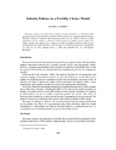Mostrar o rexistro simple do ítem
Subsidy Policies in a Fertility Choice Model
| dc.contributor.author | Gómez, Manuel A. | |
| dc.date.accessioned | 2022-02-02T08:49:53Z | |
| dc.date.available | 2022-02-02T08:49:53Z | |
| dc.date.issued | 2001 | |
| dc.identifier.citation | Gómez, M.A. Subsidy policies in a fertility choice model. Atlantic Economic Journal 29, 438–449 (2001). https://doi.org/10.1007/BF02299332 | es_ES |
| dc.identifier.issn | 0197-4254 | |
| dc.identifier.uri | http://hdl.handle.net/2183/29526 | |
| dc.description.abstract | [Abstract]: This paper compares the effects that a subsidy to health expenditure or a subsidy to childrearing costs has in a fertility choice model in which mortality is also endogenously determined. Whichever subsidy is instituted, the population growth rate rises. While a subsidy to health expenditure reduces welfare, a subsidy to child-rearing costs might increase welfare. The welfare analysis also suggests that a subsidy to health expenditure should be financed by a capital income tax, while a subsidy to child-rearing costs should be financed by a consumption tax. | es_ES |
| dc.language.iso | eng | es_ES |
| dc.publisher | Springer | es_ES |
| dc.relation.uri | https://doi.org/10.1007/BF02299332 | es_ES |
| dc.title | Subsidy Policies in a Fertility Choice Model | es_ES |
| dc.type | info:eu-repo/semantics/article | es_ES |
| dc.rights.access | info:eu-repo/semantics/openAccess | es_ES |
| UDC.journalTitle | Atlantic Economic Journal | es_ES |
| UDC.volume | 29 | es_ES |
| UDC.issue | 4 | es_ES |
| UDC.startPage | 438 | es_ES |
| UDC.endPage | 449 | es_ES |
Ficheiros no ítem
Este ítem aparece na(s) seguinte(s) colección(s)
-
II - Artigos [435]






